View From the Couch: Halloween Edition
View From The Couch is a weekly column that reviews what’s new on Blu-ray and DVD.
 FILM FRENZY
FILM FRENZY
Your source for movie reviews on the theatrical and home fronts
View From The Couch is a weekly column that reviews what’s new on Blu-ray and DVD.
The Last Voyage of the Demeter (Photo: Universal & DreamWorks)
By Matt Brunson
(View From The Couch is a weekly column that reviews what’s new on Blu-ray, 4K and DVD. Ratings are on a four-star scale.)
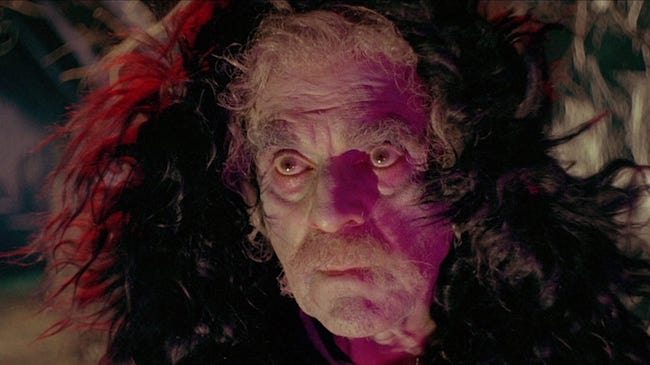
BLACK SABBATH (1963). If you’ve ever laid awake at night wondering how exactly the heavy metal band Black Sabbath came up with its name, ponder no more. Yet serving as inspiration for Ozzy and friends is the least of this classic’s merits. Despite making a handful of films in the interim, I tre volti della paura (its original Italian title, translated as The Three Faces of Fear) most confirmed the promise that writer-director Mario Bava demonstrated with his influential 1960 hit Black Sunday. First, the good news: Kino has reissued the film on Blu-ray. Now the addendum: It has reissued the American cut it released in 2015, not the original Italian version it offered in 2013. The actual edits are mostly minor, as the biggest change is that the — gasp! — lesbian subtext in the Italian cut has been completely removed for U.S. consumption. But this anthology film, with Boris Karloff serving as the cheerful host, is most effective in its original sequencing, which progresses in story terms from good to better to best — in the American version, it’s been rearranged from best to good to better. Solution: Program your player to follow the order below. “The Telephone” is a taut thriller, as the title device connects the beautiful Rosy (Michele Mercier), her jilted lover Mary (Lidia Alfonsi), and an escaped convict out for revenge. “The Wurdulak,” based on a piece by Tolstoy, rekindles that Black Sunday ambience in a period tale that stars Karloff himself as the patriarch of a family plagued by vampires. And “The Drop of Water,” adapted from a Chekhov story, features what might be the creepiest corpse in cinema history, as a nurse (Jacqueline Pierreux) makes the mistake of swiping a valuable ring from the body of a newly deceased clairvoyant.
Blu-ray extras consist of audio commentary by film critic and author Tim Lucas (Mario Bava: All the Colors of the Dark) and trailers.
Movie: ★★★

GODZILLA (1998). Forget the Emmy-winning TV special Liza With a Z — here we have the Razzie-winning theatrical stinker Godzilla With a Zzzz. Actually, the title is simply Godzilla, although a better moniker would have been Godzilla vs. Ferris Bueller since the oversized monster proves to be no match for Matthew Broderick’s incessant shtick. An overhyped, overproduced, overeverything chunk of synthetic entertainment, this American update of the beloved 1954 Japanese classic immediately makes it clear that it was made for dum-dums: An opening scene features a sign marked “Chernobyl,” and then writer-director Roland Emmerich and writer-producer Dean Devlin add a credit that reads, “Chernobyl, Ukraine,” lest stateside viewers confuse it with, I dunno, Chernobyl, South Carolina or something. At any rate, the majority of the action takes place in NYC, where the leapin’ lizard and a buncha baby ‘zillas (don’t ask) square off against such imposing figures as a nerdy scientist (Broderick), a French insurance agent (Jean Reno, on board to attract and appease the increasingly significant global audience), and Mayor Ebert (Michael Lerner), an overweight, candy-munching guy who’s always giving the “thumbs up” sign and whose balding assistant is named Gene (alas, the heavy-handed critical bashing did not extend to the inclusion of a religious wacko named Medved who gets flattened by Godzilla). This lumbering bore runs a tedious 138 minutes — in that same span, one could watch the infinitely superior 1969 animated short Bambi Meets Godzilla approximately 92 times and be all the better for it.
Extras in the 4K + Blu-ray + Digital Code Steelbook edition include audio commentary by visual effects supervisors Volker Engel and Karen Goulekas; “All Time Best of Godzilla Fight Scenes”; and the music video for The Wallflowers’ “Heroes.”
Movie: ★½

THE LAST VOYAGE OF THE DEMETER (2023). It’s an interesting slant for a Dracula flick, akin to offering a behind-the-Hamlet-scenes peek with Rosencrantz and Guildenstern Are Dead, presenting the Norwegian POV with The Thing prequel (also called, somewhat daftly, The Thing), or retaining the perpetually dropped Arctic sequences for Mary Shelley’s Frankenstein and the obscure (but worth catching) mid-70s Swedish production Terror of Frankenstein. The Last Voyage of the Demeter takes one sliver (“The Captain’s Log”) from Bram Stoker’s Dracula and spins an entire movie out of it. Set aboard the merchant ship Demeter, it charts the terrifying events that transpire as the ship journeys from Eastern Europe to London with its only cargo being big boxes of dirt. As the sailors disappear one by one, it’s up to the captain (Liam Cunningham) and a Cambridge-educated doctor (Corey Hawkins) to piece together the mystery. As with 2018’s Ophelia, the puzzle pieces don’t always fit together between the adaptation and the original source material — for instance, the film version includes an unexpected female passenger (Aisling Franciosi), a detail Stoker’s captain surely would have mentioned — but for the most part, this is a compelling terror tale that retains the flavor of Stoker but adopts the pattern of Alien (the tagline might as well have been “At sea, no one can hear you scream”). The vampire (played by Spanish genre actor Javier Botet) isn’t in the suave Lugosi/Lee vein (these puns, they write themselves!) but rather more like Max Schreck’s (and Klaus Kinski’s) grotesque Nosferatu, and superb effects work help bring the creature and its surroundings to vibrant life.
Blu-ray extras include audio commentary by director André Øvredal (Troll Hunter) and producer Bradley J. Fischer; a making-of featurette; deleted scenes; an alternate opening; and a piece on the visual effects.
Movie: ★★★

THE MIST (2007). The Mist marks writer-director Frank Darabont’s third adaptation of a Stephen King property, and, because he’s not shooting for Oscar gold this time around (the previous titles were the enjoyable but grotesquely overrated pair The Shawshank Redemption and The Green Mile), he’s able to ease up on the pedal of self-importance and deliver a “B”-style genre flick — albeit one offering some evaluations of human nature in between all the bloodletting. Owing a nod in the direction of John Carpenter’s nifty chiller The Fog, this concerns itself with a group of people who are gathered at the local supermarket when a mist envelops the entire area. It soon becomes clear that something evil resides in the fog, and the shoppers decide that they should remain indoors rather than venture out into the parking lot. It’s here that the story reveals its cynical roots, as a religious zealot named Mrs. Carmody (Marcia Gay Harden) converts many of the frightened survivors to her mode of thinking, a path that leads to a Jim Jones-like environment and at least one human sacrifice. Propelled by Harden’s scary performance, Mrs. Carmody is a genuine threat, and she validates the contention that times of crisis are as likely to turn people against each other as they are to unite them against a common enemy. The pessimism also extends to other areas of the script, most notably that powerhouse ending.
The new 4K UHD + Blu-ray + Digital edition (there’s also a Steelbook edition available only at Best Buy) contains both the original color version as well as an alternate black-and-white version. Extras include audio commentary by Darabont and producer Denise Huth; a making-of featurette; a conversation between King and Darabont; deleted scenes; and pieces on the visual effects.
Movie: ★★★

NIGHT OF THE DEMONS (1988) / NIGHT OF THE DEMONS 2 (1994) / NIGHT OF THE DEMONS 3 (1997). I’ve always been amused by the part of the tagline for Night of the Demons that reads, “Angela is having a party, Jason and Freddy are too scared to come…” Of course, were this true, it would reveal messieurs Voorhees and Krueger to be complete cowards, as there’s not a frightening moment to be found in any of the pictures in this trilogy. That’s not meant as a knock, just as an acknowledgment of the sort of low-budget horror yarns we’re dealing with here.
A perennial presence on video-store shelves back in the era, Night of the Demons finds Goth girl Angela (Amelia Kinkade) opting to throw a Halloween party at Hull House, an abandoned funeral home rumored to be filled with an unspeakable evil. The usual assortment of movie-stereotype clods assemble — the jock, the good girl, the tough greaser, the chubby guy, the sexpot (genre fave Linnea Quigley), etc. — but once a séance is held and Angela eventually gets possessed, all hell breaks loose. This is too silly to generate any semblance of unsettling atmosphere, but the monster makeup is effective, the cast is engaging (if sometimes amateurish), and there are a few (intentional) laughs thrown about. I first (and, until now, last) saw this on VHS back in the late ‘80s, and the only parts I could recall over the decades were the bookend scenes featuring that grumpy old man and his “How do you like them apples?” comeuppance.
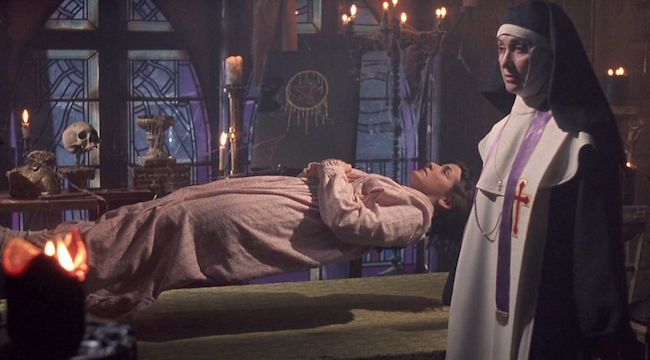
Night of the Demons made back its budget and then some, so I expect it was a handful of factors besides box office (including the passage of time) that found both of its sequels debuting on video rather than theatrically. In the case of Night of the Demons 2, that’s perhaps a shame, since it proves to be the best in the series. While still plagued by some of the issues that prevented its predecessor from soaring and scoring more highly, it does feature the best cast and the most interesting characters. The demonic Angela (Kinkade) returns to torture some more teens that dare visit Hull House on Halloween, but this time she meets a formidable opponent in Sister Gloria (Jennifer Rhodes), a no-nonsense nun who has no problem emulating Rambo by gunning down the opposition with Super Soakers filled with holy water.
The series suffers a drastic drop with Night of the Demons 3, with a workable story diluted by clumsy pacing, dopey dialogue, and a tacky visual scheme. On the run from the law, several kids (some guilty, some innocent) hide out at Hull House, where Angela (Kinkade) is waiting to cause more pain and suffering. While this letdown was the last in the original series, a remake of the 1988 flick did appear in 2009 — starring American Pie’s Shannon Elizabeth as Angela and featuring a cameo appearance by Quigley, it was a massive bomb.
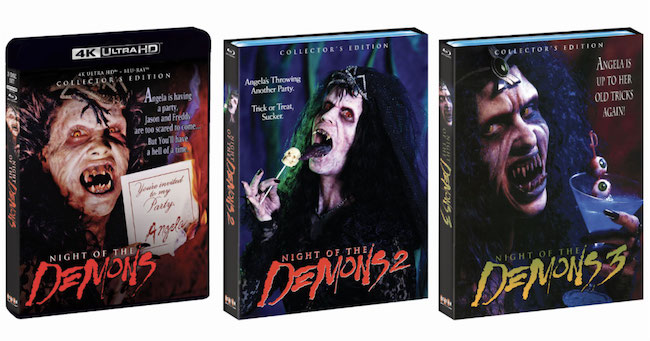
All three films are sold separately as Collector’s Editions, with the original offered as a 4K UHD + Blu-ray package while the sequels are Blu-ray only. Extras on Night of the Demons include a trio of audio commentaries by director Kevin S. Tenney and select cast and crew members; the international cut of the film; the workprint version (titled The Halloween Party); a making-of documentary; interviews with writer-producer Joe Augustyn, Kinkade, and Quigley; and a six-minute version of the film that was shown to potential distributors. Extras on Night of the Demons 2 include audio commentary by director Brian Trenchard-Smith and director of photography David Lewis; audio commentary by select cast members; the workprint of the film; interviews with Trenchard-Smith and Kinkade; and dailies. Extras on Night of the Demons 3 include audio commentary by director Jimmy Kaufman; audio commentary by Tenney (serving as screenwriter for this picture) and special effects artist Roy Knyrim; the director’s cut (actually the workprint) of the film; interviews with Kaufman, Tenney, and Kinkade; and behind-the-scenes footage.
Night of the Demons: ★★½
Night of the Demons 2: ★★½
Night of the Demons 3: ★½

PARAMOUNT SCARES VOLUME 1 (1968-2022). The first in what the studio hopes to be a series of 4K creature-feature sets, Paramount Scares offers five of its popular horror flicks covering a span of just over half a century.
Adapted from the novel by hitmaker Ira Levin (The Stepford Wives, The Boys from Brazil), Rosemary’s Baby (1968) marked the first American film for Polish writer-director Roman Polanski, who had already scored internationally with the likes of Knife in the Water and Repulsion. This box office hit emerged as one of the best chillers of its decade, and it still serves as a touchstone of the modern horror film. Mia Farrow, in the finest performance of her often erratic career, and John Cassavetes star as Rosemary and Guy Woodhouse, who move into a trendy NYC apartment where their new neighbors include a nosy but apparently well-meaning elderly couple (Ruth Gordon and Sidney Blackmer). Rosemary is elated when she becomes pregnant — even if she is confused about a particularly disturbing sex dream followed by scratches on her body the next morning — but she feels suffocated when it seems as if everyone is trying to take control of her life. Her paranoia magnifies as she comes to believe that the building residents are Satanists who are after her unborn child. A movie that builds momentum through its deliberate pacing, Rosemary’s Baby not only functions as a supernatural thriller but also predates many psychological works (including several by David Cronenberg) that tap into the universal fear of having your own body rebel against you. Polanski earned an Academy Award nomination for Best Adapted Screenplay, and Gordon won for Best Supporting Actress.

As a teenager in the early 1980s, I devoured Stephen King’s first dozen or so books (yes, including Danse Macabre) before other interests led me to bail on tackling his next offering, Pet Sematary. I never did get around to reading it, but while the plot specifics are reportedly almost identical, I have to imagine it doesn’t possess the same degree of daftness that permeates director Mary Lambert’s screen version, also named Pet Sematary (1989). Showcasing a script penned by King himself (it was the second time he adapted one of his own works, following 1985’s limp Silver Bullet), this casts Dale Midkiff and Denise Crosby as Louis and Rachel Creed, two of the most irresponsible parents ever to stumble their way onto a movie screen. Their young daughter Ellie (Blaze Berdahl) and especially their toddler Gage (Mike Hughes) would be just as well off living on their own, a point made clear once tragedy strikes the family and the adjacent pet cemetery, a former Indian burial ground with supernatural powers, provides Dad with a way to make everything OK again (or so he thinks). The premise is fascinating, but Lambert’s leaden direction (suspense is nowhere to be found), weak performances from the leads, and the frequently campy interludes (is Brad Greenquist’s walking corpse supposed to be this ridiculous?) pretty much sink this one. Fred Gwynne, however, is excellent as Jud, the folksy neighbor whose well-meaning actions eventually lead to doom and gloom. Even as a huge Ramones fan, I gotta admit that the title song doesn’t represent the band at its best.
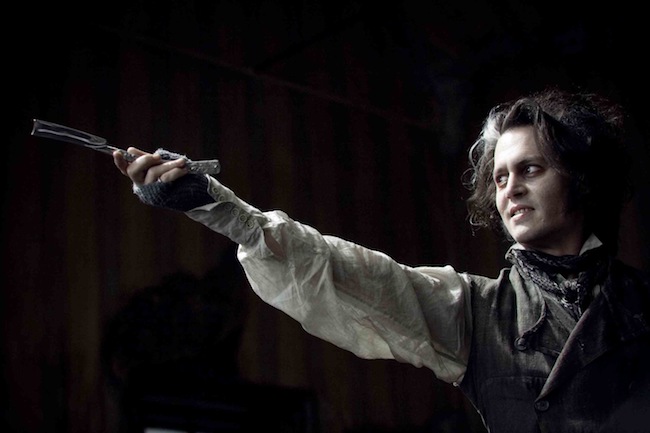
Sweeney Todd: The Demon Barber of Fleet Street (2007) is an adaptation of Stephen Sondheim’s 1979 Broadway smash, but it hides its stage roots so thoroughly that it often feels like a piece created exclusively for the screen. That’s hardly a surprise, given that, for a spell anyway, Tim Burton was one of our most visually adept filmmakers. In refashioning Sweeney Todd for cinema, he and scripter John Logan (creator of TV’s Penny Dreadful) crafted a big, bold musical that functions as an upscale slasher film: It’s bloody but also bloody good, with the gore tempered by the melancholy love stories that dominate the proceedings. Johnny Depp delivers a haunted performance as a barber who returns to London after 15 years in prison to exact his revenge on the judge (Alan Rickman) who ruined his life, while Helena Bonham Carter plays the lonely widow who aids him in his efforts. As partners-in-crime, they’re perfectly matched: He slits the throats of all who sit in his barber’s chair while she grinds up the corpses to use in her popular meat pies. Burton’s decision to stylize this film to within an inch of its life (his most theatrical flourish is to retain a Grand Guignol sense of the melodramatic) was sound, resulting in a visual feast that dazzles even through the setting’s necessary grime. Depp and Carter ably provide this rousing musical with the emotional heft necessary to prevent it from merely becoming an exercise in Gothic chic. Earning Oscar nominations for Best Actor and Best Costume Design, this won for Best Art Direction-Set Decoration.
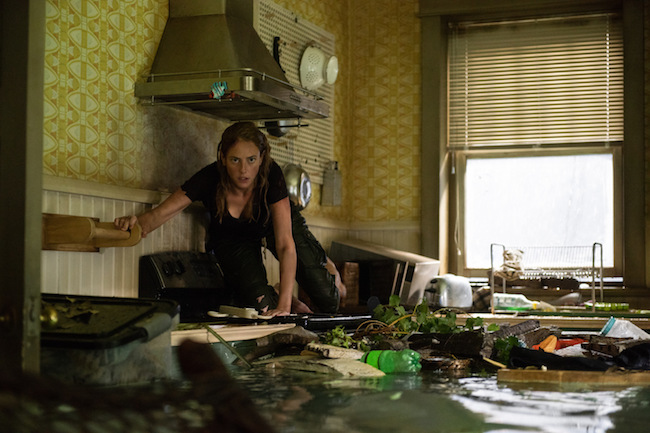
Given all the cinematic bloat these days, a pared-down thriller would seem to be a blessing, offering nothing more and nothing less than appreciated, adrenaline-pumping chills. It worked several years ago when Blake Lively stood firm against a menacing shark in The Shallows, but the idea goes belly-up with Crawl (2019). In this one, alligators are the apex predators making life miserable for the humans, as college swimmer Haley Keller (Kaya Scodelario) and her injured father Dave (Barry Pepper) are trapped in the flooded crawlspace of Dave’s Florida home while a category 5 hurricane rages all around them. Initially, there’s some tension as Haley and Dave are hopelessly pinned down by these critters, but because the script by brothers Michael and Shawn Rasmussen never offers much variation, and because director Alexandre Aja never provides a proper sense of the layout of the joint, all excitement soon dissipates. A few hapless humans wander into the frame to provide snacks for the gators, but stripped of personalities and, for the most part, even names, their ultimate fates mean little. Crawl is presumably meant to refer to the movements of both the alligators and the human protagonists, but it might as well refer to the forward momentum of the movie itself. Its solemnity results in tedium, and it’s best to turn to 1980’s Alligator instead. Embracing the more ludicrous aspects of the premise, that picture was energetic and entertaining. Crawl, on the other hand, is mostly torpid and toothless.

If the sight of a person grinning like an idiot is enough to unnerve you, then you might well be the target audience for Smile (2022) — me, I’ll stick with Jack Nicholson’s Joker for my maniacal grimaces. A psychological horror yarn that tries to cover up its slender storyline and lack of genuine thrills with an overreliance on obvious jump scares, Smile is yet another of those chillers (see also Evil Dead Rise, Malignant, It Comes at Night, Don’t Breathe, etc.) that tend to get overrated simply because there aren’t enough quality horror yarns these days to keep the niche reviewers sated. Smile is by no means bad, and it initially maintains interest with its story of a supernatural entity that uses pain and trauma to jump from one person to the next. But a repetitiveness eventually sets in (especially with a running time of a full two hours), and the ending is pretty lousy. Good performances help, particularly Sosie Bacon (daughter of Kevin Bacon and Kyra Sedgwick) in the leading role.
Even horror mavens who don’t love all five of the included titles might want to spring for this impressively packaged set, with its deep red exterior and inside goodies like a specially created issue of Fangoria looking at the quintet of movies, a Paramount Scares logo pin, and a sticker sheet. All five films are offered on 4K, Blu-ray, and Digital, with Sweeney Todd making its UHD debut. This set also brings over the numerous extras available on past releases, including a retrospective piece on Rosemary’s Baby; audio commentary by Lambert on Pet Sematary; footage from a 2007 press conference for Sweeney Todd; an alternate opening on Crawl; and deleted scenes on Smile.
Rosemary’s Baby: ★★★½
Pet Sematary: ★★
Sweeney Todd: The Demon Barber of Fleet Street: ★★★½
Crawl: ★★
Smile: ★★½

TALK TO ME (2023). From Robert Wiene’s The Hands of Orlac to Oliver Stone’s The Hand, from the Amicus portmanteau film Dr. Terror’s House of Horrors to the splatter sequel Evil Dead II, disembodied hands have long been a mainstay in horror cinema. It’s to the credit of writer-director Danny Philippou and co-director Michael Philippou that they’ve come up with a unique approach to the errant appendage, casting it as the portal through which the living can communicate with — and become briefly possessed by — the dead. When the teenage Mia (Sophie Wilde) elects to try it out in the company of her friends, she reestablishes a bond with her deceased mother (Alexandria Stefensen) that threatens not only her own relationship with her father (Marcus Johnson) but also those with her best friend Jade (Alexandra Jensen) and Jade’s younger brother Riley (Joe Bird). Considering the kids initially treat the supernatural shenanigans no differently than if they were playing a game of spin the bottle or Trivial Pursuit, it’s difficult to immediately plunge into the storyline. But once the Philippous pour on the atmosphere and flesh out the characters, the movie settles into its spooky groove, efficiently winding its way toward a Twilight Zone-worthy capper. The filmmakers deserve further credit for making their protagonist believably flawed and prone to making bad decisions — Wilde is excellent in the role, and she’s matched by Jensen and Bird. An Australian production, this was a stateside sleeper hit for A24, outgrossing all the studio’s previous pictures save Lady Bird, Uncut Gems, and champ Everything Everywhere All at Once (globally, it’s second only to EEAaO).
Extras in the 4K + Blu-ray + Digital edition include audio commentary by the Philippous; a making-of piece; and deleted scenes.
Movie: ★★★
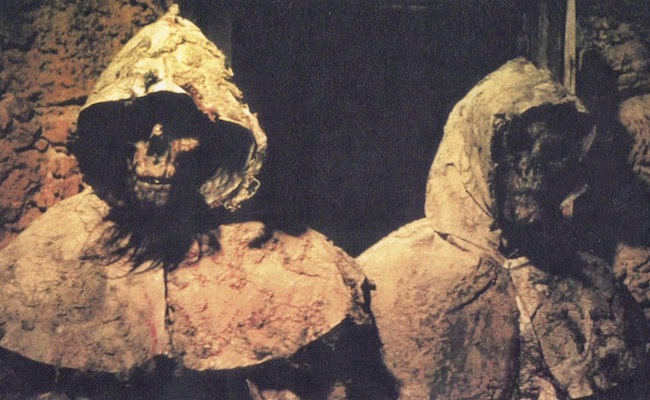
TOMBS OF THE BLIND DEAD (1972). A production between neighboring countries Spain and Portugal, Tombs of the Blind Dead (original title La noche de terror ciego, which translates as The Night of the Blind Terror) was a key film in Spain’s robust horror cycle of the 1970s. Furthermore, its success led writer-director Amando de Ossorio to make three more movies in what became known as “The Blind Dead Series”: 1973’s Return of the Blind Dead, 1974’s The Ghost Galleon, and 1975’s Night of the Seagulls. This first picture finds several folks foolishly hanging out at a desolate graveyard, one which sees its inhabitants — a band of sadistic Knights Templar — rise from the dirt and search for fresh bodies to consume. Like the critters in A Quiet Place, their sightlessness (crows plucked out their eyes while they were hung out to die) means they must locate their prey by sound alone. Character actions don’t always make sense and the connective tissue (a love triangle of sorts) feels rushed, but the authentic location shooting and the ghoul designs are top-notch. This initially played the U.S. in a heavily re-edited version simply called The Blind Dead. Then, in a particularly bizarre — and hilarious — bit of programming, another distributor, eyeing the grosses of the Planet of the Apes series, decided to add a prologue explaining how the walking dead were once intelligent apes killed by humans and have now returned; this cut was released as Revenge From Planet Ape!
The Blu-ray edition offers Tombs of the Blind Dead in its original Spanish as well as with an English/Spanish hybrid soundtrack; also on hand is the U.S. theatrical cut The Blind Dead as well as the alternate opening sequence for Revenge From Planet Ape. Other extras include three audio commentaries; a feature on the Spanish zombie flick; and a still gallery.
Movie: ★★★
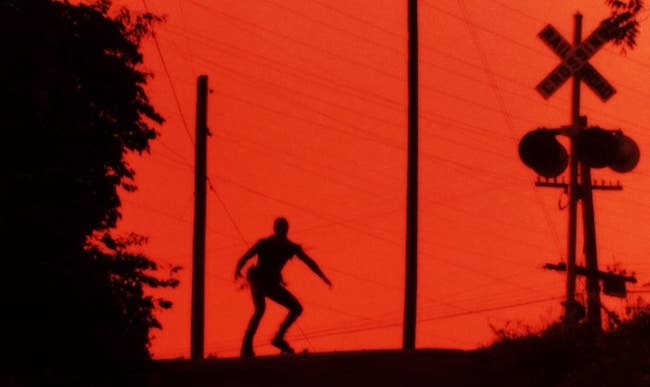
THE TOXIC AVENGER COLLECTION (1984-2000). Or “TA IN 4K,” as it’s advertised directly on the box set itself. And why shouldn’t Toxie be given the home-video upgrade? After all, he’s the star of Troma Entertainment’s most successful film, so popular a character that it’s his unsightly mug that appears on the studio logo as its official mascot. Even three flop sequels haven’t diminished the appeal of “The First Super-Hero From New Jersey.”
Created by Troma co-founder Lloyd Kaufman and directed by Kaufman and fellow founder Michael Herz, The Toxic Avenger (1984) pretty much set the blueprint for all future movies from the indie studio: broad comedy, lots of gore, smatterings of T&A, and enough non-PC material to make even Howard Stern blush. The first film in the Toxie franchise is far and away the best, sporting a frenzied and freewheeling attitude that none of the follow-ups were able to recapture. Mark Torgl plays Melvin Ferd (alternately Melvin Junko in other films), a geeky weakling who works as the janitor at a health club in Tromaville, NJ. The homicidal jocks Bozo (Gary Schneider) and Slug (Robert Prichard) are particularly cruel to clumsy Melvin, and it’s their actions that cause him to fall into a vat of toxic waste, thus transforming him into a mutated hulk (Mitchell Cohen, not to be confused with former-Trump-flunky-turned-sworn-enemy Michael Cohen) whose natural instinct is to fight evil. The Toxic Avenger is so over-the-top in everything from its violence to its villains that it’s impossible to take seriously, and Andree Maranda scores as Sara, the blind woman who becomes Toxie’s girlfriend.
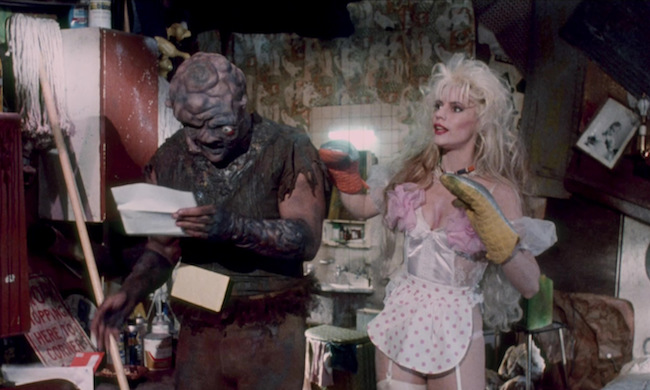
The Toxic Avenger Part II (1989) and The Toxic Avenger Part III: The Last Temptation of Toxie (1989) were originally one long film before Kaufman elected to slice and release as two pictures, and this helps explain why the two works are of comparable crumminess. Everything is still in place — the blood, the guts, the gallows humor — but nothing quite works, and the end sensation is depression more than anything else. In Part II, Toxie (John Altamura until he was fired, then Ron Fazio) travels to Japan to locate the father who abandoned him — the trip is actually a ruse by the chemical company Apocalypse Inc., which seeks to take over Tromaville while its resident superhero is away. With Part III, the title takeoff on The Last Temptation of Christ is the most clever aspect of the movie. The picture itself is as forced in its immoral mirth as its immediate predecessor, with Toxie now the unlikely spokesman for Apocalypse Inc. until he comes to his senses and fights back. The blind sweetheart in these two pictures, now named Claire instead of Sara, is played by artist and musician Phoebe Legere, but she’s not nearly as effective as Maranda in the first film.
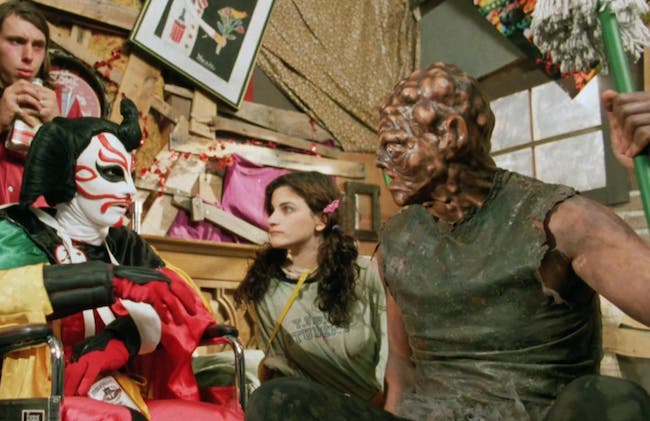
After skipping the 1990s completely, the series returned with Citizen Toxie: The Toxic Avenger IV (2000), a movie I find impossible to properly describe … or digest. The opening act, which mocks mentally challenged people and school shootings, is beyond offensive and beyond belief, and the gags couldn’t possibly be any cruder. It’s terrible … until it’s not: At some point, a specific brand of demented intelligence emerges, and it’s easier to go with the flow as this thing progresses. It’s set in a multiverse long before the MCU made the concept cool to the kids, as Toxie (now played by David Mattey) finds himself switching places with the Noxious Offender (also Mattey), the homicidal mutant who rules over Amortville. The blind girlfriend (Sara in one dimension, Claire in the other) is now played by Heidi Sjursen; the popular Troma character of Sgt. Kabukiman, N.Y.P.D. (Paul Kyrmse) appears in support; Stan Lee (billed in the credits as Peter Parker) serves as narrator; now-disgraced porn star Ron Jeremy appears as the Tromaville mayor; future Guardians of the Galaxy director James Gunn pops up as Dr. Flem Hocking (an obvious spoof of Stephen Hawking); and Hank the Angry Drunken Dwarf is God. The titular take-off on Citizen Kane is reflected in arguably the most brilliant sequence, a “News on the March”-styled bit centering on this movie’s version of Xanadu (and “Rosebud”).
Extras in the 4K + Blu-ray set include audio commentaries by Kaufman on all four films; audio commentaries by various cast and crew members on select films; introductions by Kaufman; cast interviews; and the 135-minute documentary Apocalypse Soon: The Making of Citizen Toxie.
The Toxic Avenger: ★★★
The Toxic Avenger Part II: ★½
The Toxic Avenger Part III: The Last Temptation of Toxie: ★½
Citizen Toxie: The Toxic Avenger IV: ★★½
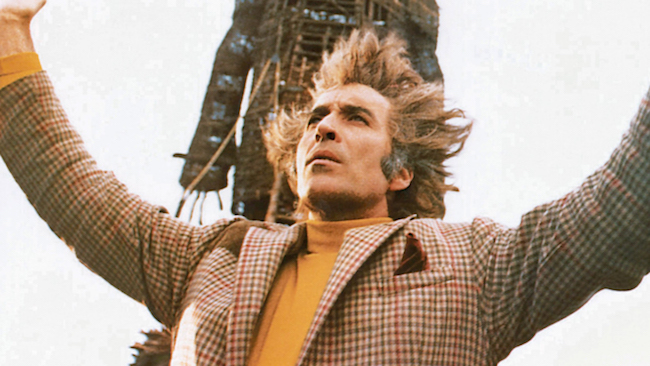
THE WICKER MAN (1973). One of the most intriguing of all cult films to emerge from the 1970s, The Wicker Man employs allegory and atmosphere to amplify its thin veneer of the supernatural — it registers as both a fantasy flick and a horror movie in our minds more than it does on the screen. Edward Woodward (best known stateside as TV’s The Equalizer) stars as Neil Howie, a humorless and devout Christian who in his capacity as a police sergeant is called to the Scottish island of Summerisle to investigate the disappearance of a 12-year-old girl. He’s shocked to learn that, under the auspices of Lord Summerisle (Christopher Lee in what the actor considered his best film and his best role), the residents are all part of a pagan society, and their upcoming harvest celebration requires the sacrifice of a virgin. Offering what ultimately can be seen as an examination of competing faiths — and, tellingly, the bleeding of one into the other — director Robin Hardy and scripter Anthony Shaffer offer up a heady stew of ambiguity and interpretation, and the ending remains one of the most shocking in cinema. Incidentally, ignore Neil LaBute’s ridiculous 2006 remake starring Nicolas Cage, which shucks religion completely and instead fashions the tale as a battle between upstanding male dominance and wicked feminist doctrine. (Oh, but do check out “Best Scenes From The Wicker Man” on YouTube; it’s fantastic.)
The Wicker Man has been reissued in a 50th Anniversary Steelbook edition that offers 4K UHD + Blu-ray + Digital Code, but note that it holds only the 94-minute Final Cut and not the 88-minute original U.K. theatrical version nor the 100-minute Director’s Cut. Extras include a 1979 interview with Hardy and Lee; a 2013 interview with Hardy; an archival interview with Ekland; and a piece on the music.
Movie: ★★★½

Short and Sweet:
THE DEVIL-DOLL (1936). Another winner from Dracula and Freaks director Tod Browning, this enjoyable outing allows Lionel Barrymore the opportunity to go the Tootsie route. He plays Paul Lavond, a Devil’s Island escapee who plots revenge against the three men who framed him for embezzlement and murder. Disguised as a sweet old lady who runs a toy shop, he benefits from the discovery of his fellow fugitive (Henry B. Walthall), a scientist who has figured out a way to shrink human beings down to the size of dolls. Engaging special effects and another robust performance from Barrymore (five years after his Oscar-winning turn in A Free Soul) contribute to the fun.
Blu-ray extras consist of film historian audio commentary; the 1936 cartoons Milk and Money (starring Porky Pig) and The Phantom Ship; and the theatrical trailer.
Movie: ★★★

PHANTOM OF THE OPERA (1943). Universal’s 1925 silent adaptation of Gaston Leroux’s celebrated novel, an enormous hit starring Lon Chaney Sr., was ripe for a sound remake, and Universal pulled out all the stops for this lavish production. As the dull hero and put-upon heroine, Nelson Eddy and Susanna Foster command the top two spots in the credits, but of course it’s third-billed Claude Rains’ character who dominates this story — in stature if not actual screen time. Numerous actors have played the part of the disfigured madman who haunts the Paris Opera House, and while Chaney remains the best (and most frightening), Rains lands in the place position for his more sympathetic handling of the role. Nominated for four Academy Awards, this won two: Best Color Cinematography and Best Color Art Direction.
4K extras include film historian audio commentary and the trailer.
Movie: ★★★
For our Hallowe’en viewing, one movie’s worth, my pick was perhaps a bit of an odd one: Lewton/Robson’s The Seventh Victim. Daria loved it, so yay!
Excellent choice! That’s probably the most underrated of all those fine Val Lewton chillers — coincidentally, I revisited it myself about eight months ago and enjoyed it as much as ever.